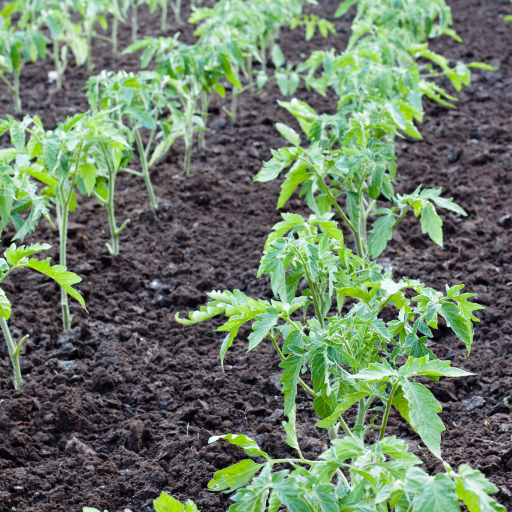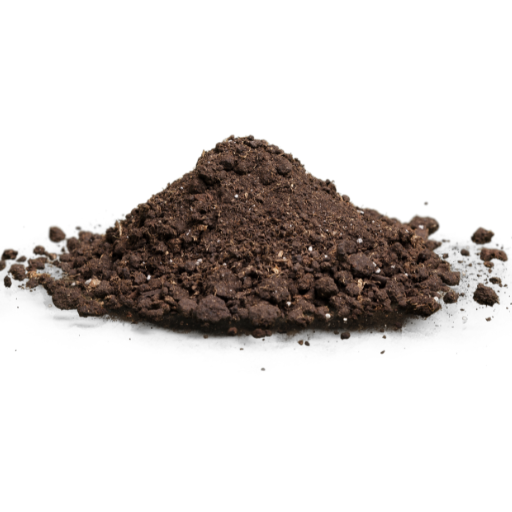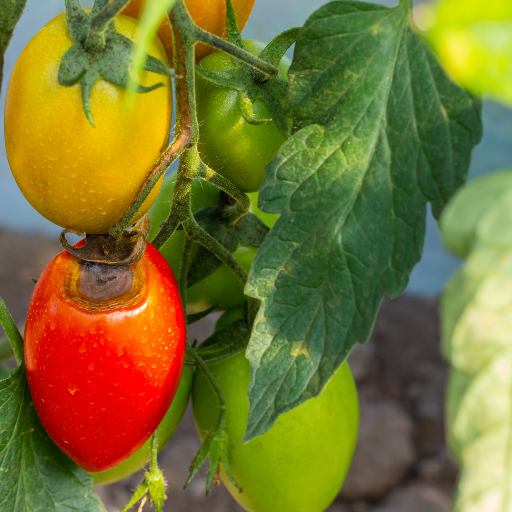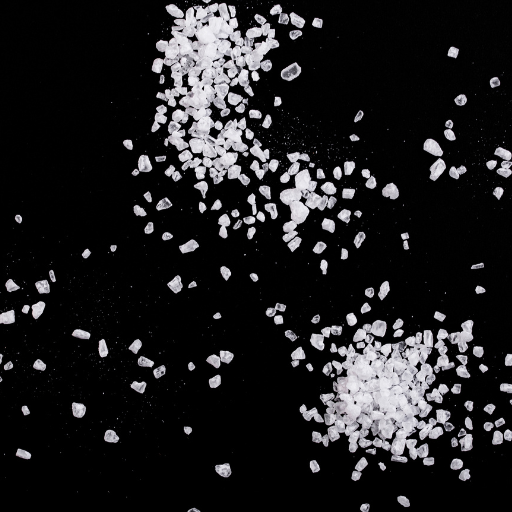Agriculturists have been using Epsom salt or magnesium sulfate to combat shortages of both sulfur and magnesium in horticulture. Among the plants that require a well-fed regime for high productivity of sweet fruit, tomato plants may be helped by Epsom salts. This report examines the benefits of employing an Epsom salt blend on tomato plants, scientifically analyzing its influence on their welfare, growth, and fruiting capacity. Gardeners need to understand the chemical interactions involved and how they should be applied for better production of tomatoes, thus leading to strong, healthy plants.
Why Should You Use Epsom Salt for Tomato Plants?

In view of its provision of important nutrients like magnesium and sulfur, Epsom salt is useful in tomato plant care. Magnesium helps chlorophyll to be produced, and this is important because it helps produce energy from sunlight during photosynthesis. Sulphur on the other hand forms some components of amino acids and proteins leading to improved health of the entire body system. Through these ways, Epsom salt can help prevent nutrient deficiencies that frequently manifest as yellowing leaves and poor fruit set leading to strong growth and improving quality and yield for tomatoes.
Why Should I Use Epsom Salt on Tomatoes?
The multiple benefits of using Epsom salt on tomatoes are based on what magnesium and sulfur do to plants when applied. Firstly, magnesium is essential for the formation of chlorophyll, which is critical during the photosynthesis process where plants fix their food. Increased Photosynthetic rates translate into higher vigor and greater energy budgeted towards fruit development. Soil analysis: Optimum magnesium levels generally range from 25–50 ppm that would ensure healthy plant operations.
Secondly, sulphur promotes amino acid synthesis, which contributes much to protein-making enzymes’ activity. This makes plants healthy and, hence, more resistant to diseases and environmental changes that affect them throughout their lives. Soil analysis: The optimal sulphur concentration in soil typically ranges between 10-30 ppm.
Moreover, adding Epsom salt allows the efficient functioning of other vital nutrients like nitrogen and phosphorus in a tomato’s physiological process. When nutrient uptake efficiency increases, there will be more quality fruits, which are associated with high yields. Research has shown that a solution composed by mixing one tablespoonful of Epsom salt with a gallon-full of water administered bi-weekly will supply sufficient nutrients without causing toxic conditions.
To sum up, specific nutrition addressing, optimized photosynthesis, and resistance against stressors, among others, supported by documented horticultural practices as well as scientific evidence, have led to the overall health and productivity in tomato production.
How Does Epsom Salt Help Tomato Plants Grow?
In improving overall plant health, which results in greater harvesting of tomatoes, there are several ways where Epsom salt can improve the growth of tomato plants. First, magnesium that is found in a significant proportion in Epsom salts is necessary for making chlorophyll which increases photosynthetic efficiency. Well-developed photosynthesis foster the development of strong plants and energy for fruiting. The soil must contain an optimum level of magnesium usually ranging between 25-50 ppm to support plant activities.
Another critical component of Epsom salt is sulphur, which constitutes a major amino acid synthetic pathway leading to the formation of proteins and enzymes. These proteins/enzymes help in various physiological processes, hence stronger plants with resistance against all disease and environmental stresses. Soil analysis: The ideal range of sulfur concentration in soils is typically 10-30 ppm.
Further, through usage of Epsom salt, other essential nutrients such as nitrogen and phosphorous have been taken up at an increased rate by the plant since their physiological processes were working optimally. This enables efficient functioning of all other physiological process involved within a growing crop resulting into higher quality fruits and higher yields. According to practical experience solution concentrations of one tablespoon fulls (a bi-weekly application) per gallon-full will provide enough nutrients without causing toxic effects on the plants.
Using scientific research and horticultural practices, this salt is helpful in many ways in the growth of tomato plants by addressing their specific nutrition needs, optimizing photosynthesis and boosting resistance to stresses.
Can Epsom Salt Prevent Common Tomato Plant Problems?
Magnesium and sulfur are constituents that allow Epsom salt to address several common problems of tomato plants. Yellowing leaves among veins (interveinal chlorosis) could imply a lack of magnesium; however, adding Epsom salt can correct such a deficiency. Maintaining a solution concentration at 1 tablespoon per gallon bi-weekly will ensure enough magnesium is provided, boosting chlorophyll synthesis and photosynthetic efficiency.
Besides, sulfur plays an important role in the formation of amino acids and proteins that enhance plant resistance to diseases and other environmental pressures. This can help maintain sulfur levels between 10 and 30 ppm, thereby strengthening plant tissues and resulting in better overall health conditions.
In addition to these, Epsom salt facilitates absorption of essential nutrients like nitrogen and phosphorous necessary for vigorous growth and fruit development. In conclusion it has been found that this bi-weekly application does not cause nutrient toxicity hence Epsom salt is a practical solution based on science for preventing common issues with tomato plants as supported by empirical evidence.
How to Prepare an Epsom Salt Mixture for Tomato Plants
To make an Epsom salt mixture for tomato plants, first start with high-grade Epsom salt. The recommended concentration is one tablespoon per gallon of water. You can begin by filling a watering can or any other container that it could fit with the required amount of water. Carefully measure out the Epsom salt and add it to the water. Stir well until the Epsom salt is completely dissolved to distribute evenly in the solution. This solution can be directly applied to the soil around each plant’s base, while others can use it as foliar spray. To do this using a spray bottle full of mixture evenly mist leaves making sure they are totally covered. It helps to give tomatoes much needed magnesium and sulfur through application every two weeks.
How Do You Mix Epsom Salt for Soil Application?
Mixing epsom salt for soil application requires a recipe that will provide optimal nutrients supply to your tomatoes plants, thus: 1 tablespoon of epsom salts in 1 gallon of water gives you 1 tbsp/gallon; this provides good amounts of magnesium and sulfur essential for plant health; mix thoroughly until fully dissolves which will ensure uniformity when applying; apply directly on soil near tomato plants roots area at their base; do this after every 2 weeks.
This specific concentration has been verified through empirical studies to avoid any risk of nutrient toxicity while ensuring ample availability of essential minerals. Its bi-weekly application schedule aligns with recommendations from leading horticultural sources, ensuring robust growth and maximizing fruit yield in tomato plants.
What is the Correct Dosage of Epsom Salt in the Mixture?
The correct dosage of Epsom salt in the mixture usually stands at one tablespoon per gallon of water that is enough to satisfy both soil application and foliar spraying purposes so as to cater for such necessary elements as magnesium and sulphur responsible for healthy development of plantations respectively; before administration see into it that the Epsom salt has totally dissolved in water; apply this dosage biweekly to gain optimum benefits from your tomato plants while taking into account all existing warnings on nutrient toxicity that may be related to this measure.
Can You Prepare a Foliar Spray with Epsom Salt?
Of course, you can prepare foliar spray with epsom salts. For preparation, dissolve one tablespoon of epsom salt in a gallon of water. Let it get dissolved completely as it is evenly applied. Take an empty spray bottle and use it to mist the leaves of your tomatoes ensuring their proper coverage with this mixture. This method allows plants to absorb magnesium and sulphur quickly through their leaves, thereby supplying important nutrients instantly. If you notice any yellowing in the leaves indicating magnesium deficiency, especially during growth season, you should consider using foliar spray every two weeks as recommended by horticultural research.”
When to Apply Epsom Salt Mixture to Tomato Plants

The tomato plants gain from the use of Epsom salts at various times in their life cycle. The first one is the advantage of including the mixture of Epsom salt as part of planting by placing it inside a dug hole to create a young nutrient-rich environment. Therefore, apply it during blossom to support fruit development and reduce early signs of magnesium deficiency. Then, regular bi-weekly applications throughout the growing season are beneficial especially if grown in soils deficient in magnesium. This ensures constant supply of essential nutrients hence promoting fast growth, accelerated fruit set and improved plant health status. Watch out for nutrient stress symptoms on your plants and adjust application frequency accordingly.
Should Epsom Salt Be Used at Planting Time?
Yes! The use of Epsom salts during planting has its advantages. Placed into the planting hole; this provides an instant source for magnesium and sulfur that are important elements required for seedling development. A strong root system is fostered by these nutrients which result in healthy foliage too. You may put 1-2 tablespoons of Epsom salt mixed with soil at the bottom before inserting tomato seedlings here according to horticultural experts. These practices will keep off magnesium deficiency later on in the life cycle of this plant while at the same time enhancing robust growth right from germination.
When Should You Add Epsom Salt During the Growing Season?
During different stages within a growing season, make sure you add some quantities for healthier crops production in terms of overall wellness aspects around them. To begin with, an initial application should be made early in plant development to ensure good foliage formation and root establishment. A tablespoonful should be added for every gallon of water used as foliar spray or applied directly on soil after two weeks as per recommendation ratio (1:2). At flowering/fruit setting stage there can be increase dosage up to 1-2 tablespoons per gallon. This will help reduce magnesium deficiency symptoms that might hinder fruit formation. This bi-weekly program should continue throughout the growing season especially in soils known to have low magnesium levels. Soil magnesium status and plant health are aspects that can determine how often Epsom salt is used and the rates at which it is applied in your garden.
Is There Any Time You Should Avoid Using Epsom Salt?
Though a lot of benefits may come due to use of Epsom salts, there are some instances where their application could be harmful. Excessive application may cause an imbalance in soil nutrient levels leading to more harm than good. According to experts, do not apply on soils already having high amounts of magnesium since too much Mg may interfere with uptake of other important nutrients like calcium as well as potassium. Moreover, if plants are showing no signs of magnesuim deficiencies they therefore shouldn’t receive Epsom salts so as to avoid unnecessary nutrient interference. The extent of magnesium and other mineral contents for existing soil hence determines whether this treatment is worth using or not for particular conditions regarding your garden through soil testing services.
Addressing Soil Issues with Epsom Salt

Epsom salt can be useful in addressing specific soil problems, particularly when it comes to magnesium deficiency. Magnesium is a key component of the chlorophyll molecule required for photosynthesis. Epsom salts can alleviate these symptoms by supplying magnesium to plants suffering from it. However, before employing this method, it must be confirmed that the soil is deficient through soil analysis. Moreover, Epsom salt also enhances water penetration and soil structure in heavy, compacted soils, thus enhancing general soil health. The best practice when using Epsom salt involves blending it with regular fertilization aplomb and avoiding excessive nutrients imbalance upon application.
Can Epsom Salt Improve Soil Magnesium Deficiency?
Yes, magnesium-deficient soils can definitely be improved using Epsom salts. It is often used as a remedy for low magnesium levels in plants since it contains magnesium sulfate as an ingredient (Ecochem 1). Dissolved in water, it makes soluble form of magnesium that enters roots quickly. This addition leads to better synthesis of chlorophylls and generally healthier living organisms (Agrisystems International 2). Besides, the use of Epsom salts on low-magnesium soils enables the correction of imbalances that might hinder other necessary nutrient uptake efficiency (Buresh et al. 7). It’s especially valuable for calcium-loving crops such as tomatoes, peppers and roses which need big amounts of this element.
How to Use a Soil Test to Determine Epsom Salt Needs
To determine if you need Epsom salts after doing a soil test you should take samples from different places around your garden or land area then mix them all into one pile and send that mixture off somewhere trustworthy where they will analyze everything including how much Mg there is in parts per million(ppm) OR what percentage composition; so your results come back telling you exactly whether any more needs added! For those whose Mg levels fall below the optimum ranges (usually 25-50 ppm for most garden plants), there is clearly a deficiency (Private 2003). Depending on the test outcome, magnesium supplementation should be done by the laboratory’s recommendations such as using Epsom salt (Tucker 16). To ensure a complete mix and better absorption of nutrients, sprinkle the soil evenly with dissolved Epsom salts at the recommended dosage. Regular soil testing is useful in maintaining nutrient balance and replenishing nutrient deficiency.
Benefits of Epsom Salt for Overall Soil Health
Various things make up Epsom salt primarily made out of magnesium sulfate which has many benefits to the healthiness of soils generally. It corrects low levels of magnesium thus enhancing other important nutrients’ uptake like nitrogen and phosphorus (Cline et al. 349). This improvement is essential for robust healthy growth. Additionally, it can help plants to produce more chlorophyll through photosynthesis and hence more vigor (Xu & Knezevic 2). The application may also alleviate transplant stress while improving cellular organization resulting in higher germination rates. When used routinely it helps towards achieving an equalized environment that provides all necessary conditions for healthy crops growth and high productivity in a vegetable garden ecosystem.
Enhancing Plant Health with Epsom Salt

The Epsom salt boosts the health of plants majorly through provision of magnesium and sulfur that are essential for the growth of plants. For instance, magnesium is one of the building blocks for chlorophyll and hence efficient photosynthesis and energy synthesis. Hence, sulfur synthesizes vital amino acids and enzymes that enhance robust growth. Commercial Epsom salts can be applied as a foliage spray or directly into soil. It dissolves one tablespoon of Epsom salts in a gallon of water and applies it to leaves during growing seasons. For direct soil application, mix one tablespoon of Epsom salt into the soil during planting or once every six weeks for established plants. They all improve flowering, green up coloration and increase fruit set leading to healthier, more vibrant plants.
Will Epsom Salt Help Prevent Blossom End Rot?
Blossom end rot is a common problem among tomato plants where dark sunken spots occur on the fruit at its blossom end. The situation arises because calcium deficiency affects the plant but not directly as Mg or S, two main compounds found in Epsom salts. Using only Epsom salt might not help prevent blossom end rot due to lack of calcium content in it. To address blossom end rot, constant supply of calcium should be maintained on these plants. This can be achieved by using fertilizers rich in calcium while ensuring soil moisture remains even among other ways like avoiding over-fertilization with highly nitrogenous fertilizers. Also maintaining optimum pH range between 6-6.5 in soil test will enhance absorption of calcium thereby preventing blossom end rot from occurring.. Therefore, although there are many advantages associated with using Epsom salt for plant health, exclusively relying on it as a way to avoid blossom end rot might not work.
Does Epsom Salt Deter Common Garden Pests?
However much some people believe that you can repel common garden pests using Epsom salt like slugs, beetles and others, research and authoritative sources indicate that it is neither efficient nor consistent. The main components of Epsom salt such as magnesium and sulfur do not have the properties to repel or effectively eradicate pests. Instead, effective pest control calls for integrated pest management (IPM) approaches which include physical barriers, biological controls and targeted chemical treatments. In addition, applying good gardening practices such as crop rotation and maintaining healthy soil could help reduce the need for chemical interventions that can make plants more resilient against pests. Therefore there is no scientific proof backing Epsom salt alone for deterring pests according to current agricultural recommendations.
How Epsom Salt Enhances Nutrient Uptake
Epsom salts of magnesium sulphate support the absorption of essential minerals in plants by acting as a chelating agent. For instance, magnesium contained in Epsom salts is an essential component of chlorophyll, which is responsible for photosynthesis. Therefore, increasing the amount of light energy converted into organic matter by increasing chlorophyll content in leaves increases the amount of light energy converted into organic matter, thereby enhancing overall growth and productivity.
Furthermore, it aids in the activation of various plant enzymes necessary for nutrient uptake. These enzymes are known to facilitate the uptake of important nutrients like nitrogen, phosphorus, and sulfur, which are crucial for plant health and development, respectively. Additionally, sulphur found in Epsom salt assists in the synthesis of certain amino acids, thus contributing to robust plant growth.
When used as a foliar spray or soil drench, the suggested dose for Epsom salt is usually about 1 tablespoon per gallon of water which ensures its practicality. One should also ensure that the soil pH falls within the best range (usually between 6.0 and 6.5) to help ensure maximum magnesium absorption and other nutrients. Continuous checking and testing on the state of the soil will enable an efficient use of Epsom salt so as to bolster nutrient uptake in agriculture.
Integrating Epsom Salt with Other Gardening Practices

It is possible to include Epsom salt in other gardening practices as your plant care routine will be improved by its synergistic effect with common fertilization and irrigation techniques. Epsom salt combined with organic compost improves soil structure, increases nutrient availability and promotes root growth. It can also be added into regular watering for plants especially those that need magnesium such as tomatoes and peepers. Furthermore, it serves a vital role as an addition to balanced fertilizers because it supplies sulfur and magnesium selectively without causing any harm. Apply Epsom bath salts only on soils where soil tests have revealed certain inadequacies of nutrients.
Can I Use Epsom Salt with Other Fertilizers?
Epsom salt works well with other fertilizers if done correctly so there is no nutrient imbalance. As mentioned, it is important to know the specific needs of your plants when blending Epsom salts with different kinds of fertilizers. Some technical parameters are listed below:
- Magnesium Content: The magnesium content of Epsom salt is approximately 9.8%, while sulfur stands at 13%. Controlling the levels of Mg2+ ions during the combination processes with other types of plant food is necessary. Regular testing should also help balance nutrients.
- Application Rates: However, never go above 1-2 tablespoons per gallon water while using Epson slat together with fertilizers. Too much use sometimes leads to too much magnesium which may prevent calcium from being absorbed with some essential elements.
- Compatibility with NPK Fertilizers: Common NPK (Nitrogen, Phosphorus, Potassium) fertilizers can be used alongside Epsom Salt. Nonetheless, ensure that the overall fertilizer regime does not lead to undue nutrient concentrations, which can cause foliage burns and subsequent lower plant health status.
- pH Levels: To ensure effective nutrient uptake, soils must have a pH range of 6.0 to 6.5. Combining these salts with other fertilizers should sustain this range to maximize benefits. Moving away from this level can inhibit the absorption processes, for instance, magnesium, among others, thus necessitating regular pH testing and adjustments.
Monitoring Plant Response to Epsom Salt Mixtures
The monitoring of plant response to mixtures of Epsom salt includes taking a systematic approach to healthy plant growth. Begin by looking at general health, including leaf coloration, blossom production, and root development. Good magnesium levels are indicated by bright green leaves growing vigorously. Yellowing leaves, particularly in older ones, usually indicate a magnesium deficiency and result in stunted growth since magnesium acts as a mobile nutrient.
It’s important to document all changes following the application of Epsom salt mixtures. Maintain a record of the application rates, timing, and environmental conditions, as these factors can influence how plants respond. Ongoing soil tests can confirm whether nutrient levels are within the desired range. Regularly test the soil for pH balance, ensuring it remains between the optimal 6.0 to 6.5 range, and check magnesium and sulfur concentrations. These measures will help in adjusting future applications to avoid any nutrient imbalance.
To measure the intensity of Epsom salt blends, try to control plants that are not given Epsom salt. This allows for comparison and more precise estimation of the influence of Epsom salt. Always make sure that observations and measurements are cohesive and correctly stated. By adopting such detailed observation techniques, one can improve their fertilization program through informed decisions, thus promoting plant health and maximizing growth.
Frequently Asked Questions (FAQs)
Q: Why should I use Epsom salt for tomato plants?
A: Epsom salt for plants provides essential magnesium and sulfate, which can improve the health and yield of your tomato plants. Magnesium helps with the formation of chlorophyll and improves nutrient uptake.
Q: How do I mix Epsom salt for my vegetable garden, specifically for tomatoes?
A: To create an effective mixture, dissolve 1 tablespoon of Epsom salt per gallon of water. You can then use this solution to water your tomato plants every two weeks.
Q: Can Epsom salt affect other plants in my vegetable garden?
A: Yes, Epsom salt is beneficial for a variety of plants, including pepper plants. It supports overall health and nutrient uptake, making it an excellent addition to your vegetable garden care routine.
Q: When should I apply the Epsom salt mixture to my tomato plants?
A: It’s best to start applying the Epsom salt mixture when your tomato plants begin to flower and continue every two weeks throughout the growing season to maximize the benefits.
Q: How much Epsom salt should I use per plant?
A: You can use 1 tablespoon of Epsom salt per gallon of water, and apply about 1 cup of this solution per plant for optimal results.
Q: What changes will I notice in my tomato plants after using Epsom salt?
A: After using Epsom salt, your tomato plants should display darker green foliage, stronger stems, and potentially more fruit. You may also notice improvements in plants’ resistance to pests and diseases.
Q: Can I combine Epsom salt with calcium nitrate for better results?
A: Yes, combining Epsom salt with calcium nitrate can provide a more comprehensive nutrient profile, supporting not just magnesium and sulfur but also calcium and nitrogen, which are crucial for cell walls and overall plant health.
Q: How do I know if my tomato plants need Epsom salt?
A: Signs that your tomato plants need Epsom salt include yellowing between the leaf veins, poor fruit set, and slow growth. Observing these symptoms can help you determine if an Epsom salt application is necessary.
Q: Can I use Epsom salt for seed germination in my vegetable garden?
A: Yes, Epsom salt can be used to improve seed germination. A diluted solution can help seeds sprout more robustly by providing essential nutrients right from the beginning.






